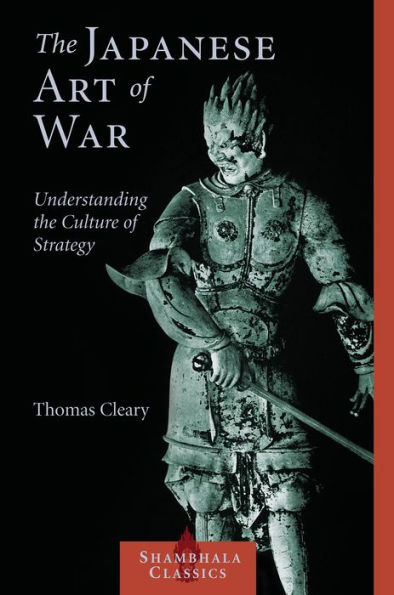

eBook
Related collections and offers
Overview
Military rule and the martial tradition of the samurai dominated Japanese culture for more than eight hundred years. According to Thomas Cleary—translator of more than thirty-five classics of Asian philosophy—the Japanese people have been so steeped in the way of the warrior that some of the manners and mentality of this outlook remain embedded in their individual and collective consciousness.
Cleary shows how well-known attributes such as the reserve and mystery of formal Japanese behavior are deeply rooted in the ancient strategies of the traditional arts of war. Citing original Japanese sources that are popular among Japanese readers today, he reveals the hidden forces behind Japanese attitudes and conduct in political, business, social, and personal life.

Product Details
| ISBN-13: | 9780834824553 |
|---|---|
| Publisher: | Shambhala |
| Publication date: | 05/10/2005 |
| Sold by: | Penguin Random House Publisher Services |
| Format: | eBook |
| Pages: | 144 |
| Sales rank: | 858,699 |
| File size: | 1 MB |
About the Author
Read an Excerpt
Introduction
Use anger to throw them into disarray, use humility to make them haughty.
Tire them by flight, cause division among them.
Attack when they are unprepared, make your move when they do not expect it.
Be extremely subtle, even to the point of formlessness,
Be extremely mysterious, even to the point of soundlessness,
Thereby you can be the director of the opponent's fate.
—Sun
Tzu,
The
Art of War
During one of the recent flare-ups of trade friction between the United States and
Japan, a prominent critic was complaining to a member of the Diet about the
Japanese attitude toward international relations. The critic contended that even as Japan claims it is misunderstood, it does not try to make itself understood. The dietman smiled ironically. "
That,"
he said, "is Japanese!"
Perhaps everyone has heard of the mysterious East or the inscrutable Orient. It may be assumed that the Japanese are inscrutable, for example, because Oriental cultures are inherently difficult for outsiders to understand. Less frequently suspected is the originally deliberate and later subconscious use of bafflement and mystification, as part of the ancient art of war.
All sorts of Western attempts to take advantage of Japanese resources, from their economic power to their Zen Buddhism, have been thwarted or distorted by bafflement and mystification, in cases where the ulterior logic and method of bafflement and mystification are unknown. The impression of mystery may appear to veil a secret, but the main secret may turn out to be that mystery itself is a weapon, an art of war.
The veil of mystery is just one of the arts of war that permeate Japanese political, cultural, and social life. For those trying to understand the
Japanese mind and civilization—and that may include anyone involved in the modern world—there is no practical way to overlook the military rule and martial culture that have dominated Japan for many centuries, virtually up to the present day. So steeped in the way of the warrior has Japanese civilization been that some of the manners and mentality of this outlook remain embedded in the deepest strata of the individual and collective unconscious of that nation.
The sword is one of the three basic symbols of Shinto, the ancient Japanese religion, and so of the imperial heritage, which emerged after centuries of racial and tribal wars in ancient Japan. The sword became the soul of the samurai, who gradually extended their control from the frontiers and provinces to become the dominant power in Japan for nearly eight hundred years.
Even in the social and cultural spheres, Japan today still retains indelible impressions of the samurai Bushido, the way of the warrior. This is true not only in education and the fine arts, but also in characteristic attitudes and conduct marketing the course of political, professional, and personal relations. Well-known attributes such as the reserve and the mystery of formal
Japanese behavior, as well as the humility and the hauteur, are deeply rooted in the ancient strategies of the traditional art of war. To understand Japan and the Japanese in depth, therefore, it is essential to understand the culture of strategy crafted by the Japanese art of war.
Table of Contents
Introduction
1
The inscrutable East: mystification and the art of war · Bushido and Japanese behavior
A
Martial History of Japan 3
Conquest,
civil war, militarism, and the rise of the samurai caste
Zen in Japanese History 12
Zen in Japanses politics, politics in Japanese Zen
Bushido and Martial Arts 20
The professional warrior's attitude · commercialization of martial arts ·
organization of a warrior's training · use of Zen psychology in practical education · defense and invulnerability · timing and success ·
starting on the way
The
Way of the Zen Warrior 39
Theory and practice · expertise and adepthood · fixation and freedom ·
Buddhism and everyday life · artificial Zen · self-mastery ·
transcendental ethics · daily life of warriors · buoyancy and depression · awareness and timing · mind and action
Schemes of the Samurai 68
Ethics of warfare · the vanguard of the moment · energy, feeling, and mood
· strategy in social and professional relationships · appearance and intention · expediency · strategic mystery · fluidity on the warrior's way · first strike, second strike · disarming opponents
· ways of winning
The
Thirty-Six Strategies 86
Classical foundations of the science of conflict · root teachings on the art of war
Bushido and Christianity: Ethical Crossroads 92
Zen,
society, and morality · pseudo-Christian imperialism and Japanese xenophobia
A
Zen Razor 116
Ignorance and misdirection · artificial esoterism · distinguishing Bushido from
Buddhism · the Shinto connection · militarism in Japanese society and psychology
Summary
123
Index
127
